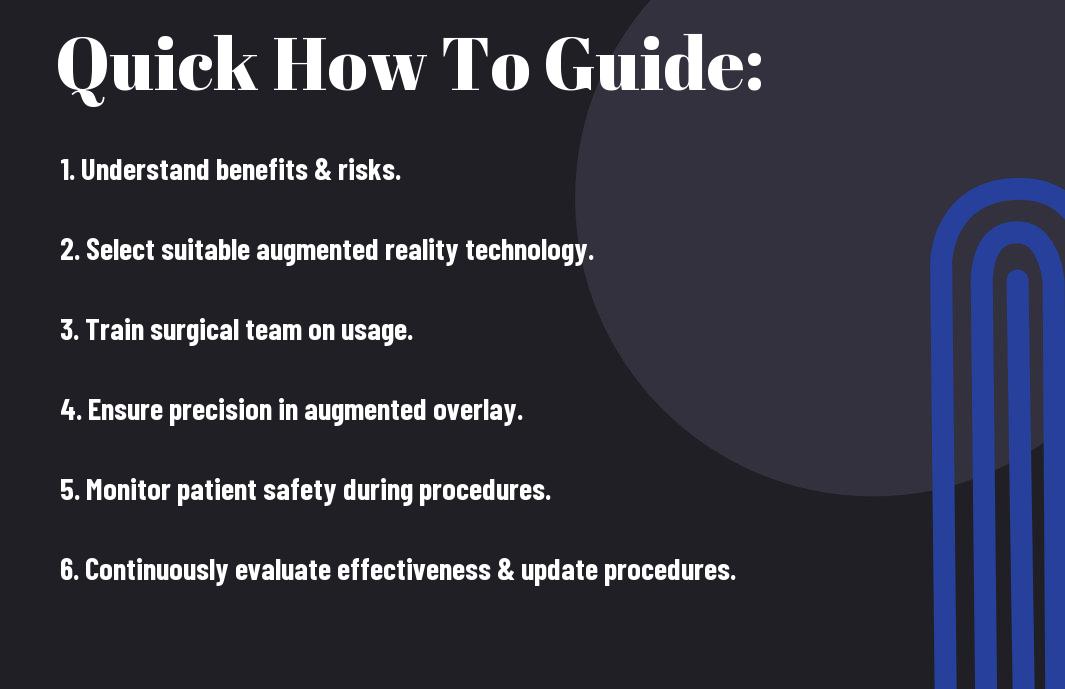Is Augmented Reality The Key To Enhanced Surgical Procedures? You may wonder how augmented reality is revolutionizing the field of surgery. In this guide, I will explore the incredible potential of AR technology in enhancing surgical procedures. Discover how surgeons are benefiting from real-time data, 3D visualizations, and enhanced precision in the operating room. Join me as we examine into the future of medicine and how AR is shaping the next generation of surgical innovation.
Table of Contents

How to Revolutionize Surgical Procedures with Augmented Reality
Tips for Implementing AR in the Operating Room
The implementation of Augmented Reality (AR) in the operating room can greatly enhance surgical procedures. To ensure a successful integration, consider these tips:
- Ensure proper training for surgeons and medical staff.
- Calibrate AR systems for optimal precision.
- Regularly update and maintain AR devices.
Though challenges may arise, the benefits of utilizing AR in surgery are boundless.
Optimizing Windows Performance Tips to Speed Up Your PC

Factors to Consider When Selecting an AR Platform
Even with the advancements in technology, choosing the right AR platform for surgical procedures is crucial. Consider the following factors:
- Compatibility with existing medical equipment.
- Reliability and accuracy of the AR system.
- Cost-effectiveness and scalability for future upgrades.
With the right platform, surgical procedures can be streamlined and improved, ultimately benefiting both patients and surgeons.
Enhancing Surgical Precision with AR

How to Use AR to Improve Visualization and Navigation
One way to enhance surgical precision using augmented reality (AR) is by improving visualization and navigation during procedures. With AR technology, you can overlay images directly onto the patient’s anatomy, providing real-time guidance and enhancing your ability to see critical structures in 3D. This increased visualization can help you make more precise incisions and navigate complex anatomy with accuracy.
Tips for Reducing Errors and Complications with AR Guidance
Improve your surgical outcomes by utilizing AR guidance to reduce errors and complications during procedures. Implementing real-time feedback and guidance can help you stay on track and avoid potential pitfalls. By incorporating virtual markers and pathways, you can enhance your surgical precision and ensure that you are in the correct anatomical plane. Assume that continuous updates and calibration are necessary to maintain accuracy throughout the procedure.
Navigation
When using AR for surgical procedures, navigation plays a crucial role in ensuring optimal outcomes. By leveraging AR technology, you can improve your ability to navigate complex anatomy and identify critical structures with enhanced clarity. Additionally, incorporating real-time feedback and guidance can assist you in making precise movements and avoiding potential risks. Always prioritize patient safety and accuracy when utilizing AR for surgical navigation.
The Future of Surgery: How AR Will Transform the Field
Not only is augmented reality (AR) revolutionizing the way we approach surgical procedures, but it is also poised to significantly transform the field of surgery as a whole. With the ability to overlay digital information onto the physical world in real-time, AR technology offers surgeons a new level of precision, accuracy, and efficiency in the operating room.
Factors Driving the Adoption of AR in Surgery
Little by little, advancements in technology are pushing the boundaries of what is possible in the field of surgery. Improved visualization, enhanced training opportunities, and reduced margin of error are some of the key factors driving the adoption of AR in surgical procedures. The potential to enhance patient outcomes and shorten recovery times make AR an enticing option for hospitals and surgeons alike. The future of surgery is being reshaped by the integration of AR technology, and it’s only a matter of time before it becomes the standard practice in operating rooms worldwide.
How to Stay Ahead of the Curve in AR-Enhanced Surgery
For me, staying ahead of the curve in AR-enhanced surgery involves embracing and adapting to new technologies as they emerge. With the rapid pace of innovation in this field, it’s crucial to continuously educate yourself on the latest advancements and seek out opportunities for hands-on experience with AR systems. By collaborating with experts in the field and actively participating in training programs, you can ensure that you are well-equipped to provide the best possible care for your patients. The future of surgery belongs to those who are willing to embrace change and innovate with cutting-edge technologies.
To wrap up
On the whole, embracing augmented reality in surgical procedures could revolutionize the way surgeries are conducted. The ability to visualize complex structures in 3D, improve precision, and enhance communication among medical teams can lead to safer and more successful operations. As technology continues to advance, your skills as a surgeon combined with the power of augmented reality can pave the way for even better patient outcomes in the future.
Q: What is augmented reality (AR) in the context of surgical procedures?
A: Augmented reality (AR) is a technology that superimposes computer-generated images, sounds, or other data onto the real-world environment. In the context of surgical procedures, AR allows surgeons to see relevant information overlaid on the patient’s body, helping them visualize critical structures and make more informed decisions during surgery.
Q: How does augmented reality enhance surgical procedures?
A: Augmented reality enhances surgical procedures by providing surgeons with real-time, interactive guidance. By overlaying digital information onto the surgical field, AR can help surgeons navigate complex anatomical structures, accurately locate tumors or other targets, and ensure precise placement of instruments. This can lead to improved surgical accuracy, reduced complications, and better patient outcomes.
Q: What are the potential benefits of using augmented reality in surgery?
A: The potential benefits of using augmented reality in surgery are numerous. These include improved surgical precision, enhanced visualization of structures that are difficult to see with the naked eye, reduced operating times, minimized risk to surrounding tissues, and enhanced training opportunities for surgeons. Overall, AR has the potential to revolutionize the way surgeries are performed, making them safer, more efficient, and ultimately leading to better patient care.
